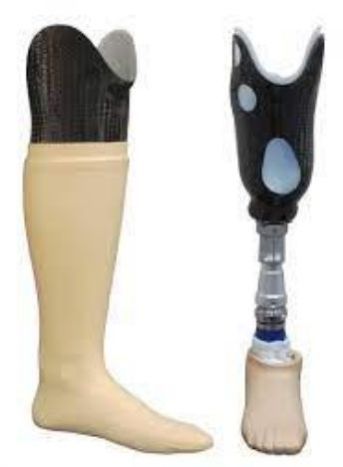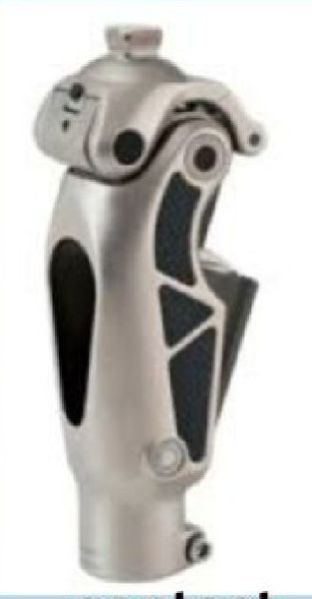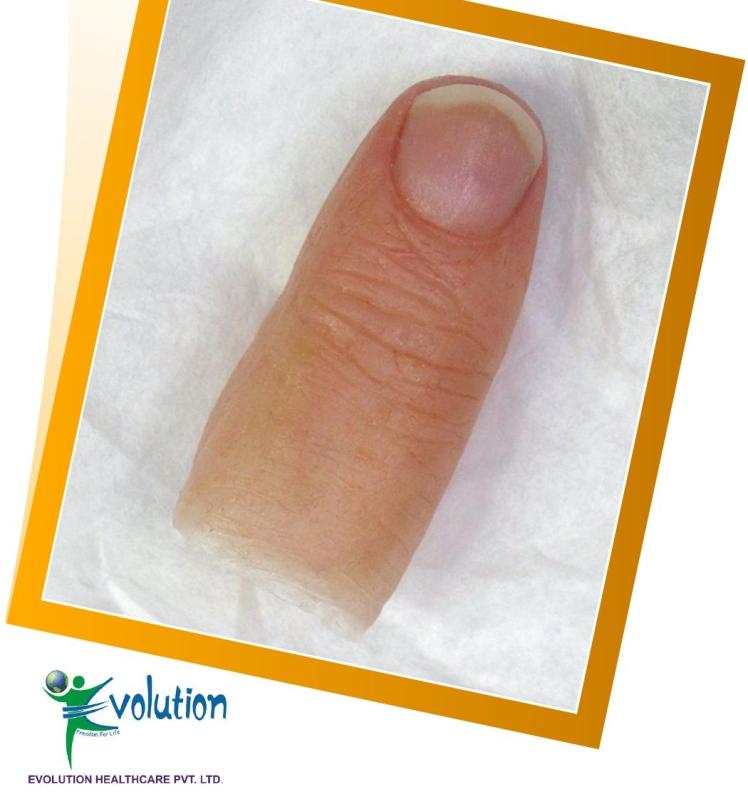Silicone Prosthesis
Leading Manufacturers, Exporters, Wholesaler, Retailer and Trader of Artificial Limb, Pneumatic Prosthetic Knee op4, Silicone Ear Prosthesis, Silicone Finger Prosthesis and Silicone Nose Prosthesis from Surat.
| Business Type | Manufacturer, Exporter, Supplier, Retailer, Trader, Distributor, Importer, Buying House |
| Brand Name | Evolution Healthcare Pvt. Ltd. |
| Delivery Time | 10 |
At Evolution Healthcare Pvt. Ltd., we specialize in manufacturing world-class artificial limbs that restore mobility and transform lives. Our wide range of prosthetic limbs is designed to meet the needs of individuals who have experienced limb loss due to injury, illness, or congenital conditions.
\r\nWhat is an Artificial Limb?\r\nAn artificial limb, also known as a prosthetic limb, is a custom-made device designed to replace a missing leg or arm and restore functionality and appearance. It helps amputees regain independence, improve quality of life, and return to daily activities with confidence.
\r\n\r\nOur Range of Prosthetic Solutions Includes:\r\n- \r\n
- \r\n
Prosthetic Legs (Lower Limb Prosthesis): For above-knee (AK) and below-knee (BK) amputations.
\r\n \r\n - \r\n
Prosthetic Arms (Upper Limb Prosthesis): For above-elbow and below-elbow amputations.
\r\n \r\n - \r\n
Custom-Made Artificial Limbs: Tailored to fit individual anatomy, activity level, and lifestyle.
\r\n \r\n - \r\n
Lightweight & Durable Designs: Made using advanced materials like carbon fiber, aluminum, and medical-grade silicone.
\r\n \r\n
- \r\n
- \r\n
✅ Anatomical Design for a natural look and feel
\r\n \r\n - \r\n
✅ Comfortable Fit with soft liners and adjustable sockets
\r\n \r\n - \r\n
✅ Lightweight Structure for easy movement and reduced fatigue
\r\n \r\n - \r\n
✅ High Durability for long-term, everyday use
\r\n \r\n - \r\n
✅ Custom Fitting and Alignment to ensure maximum functionality
\r\n \r\n - \r\n
✅ Support for All Age Groups – pediatric to geriatric prosthesis
\r\n \r\n
- \r\n
- \r\n
Over 12 years of experience in prosthetic and orthotic device manufacturing
\r\n \r\n - \r\n
Certified professionals and prosthetists for accurate fitting and follow-up
\r\n \r\n - \r\n
PAN India services and global exports to Africa and Southeast Asia
\r\n \r\n - \r\n
Advanced technology including 3D design, CAD/CAM, and custom fabrication
\r\n \r\n - \r\n
Affordable solutions tailored for the Indian environment and economy
\r\n \r\n
- \r\n
- \r\n
Post-traumatic amputation rehabilitation
\r\n \r\n - \r\n
Limb loss due to diabetes or vascular disease
\r\n \r\n - \r\n
Congenital limb deficiency support
\r\n \r\n - \r\n
Mobility restoration for military veterans and accident survivors
\r\n \r\n
\r\n
Whether you need a prosthetic leg, artificial arm, or a fully custom limb prosthesis, our expert team is here to help you every step of the way. From consultation and fitting to training and aftercare, Evolution Healthcare ensures a seamless rehabilitation journey.
| Business Type | Manufacturer, Exporter, Supplier, Distributor, Importer |
| Brand Name | Evolution Healthcare Pvt.Ltd.,ossur |
| Color | aluminium |
| Size | fix |
| Length | 15 inch |
| Type | Functional Prosthetic,pneumatic knee joint |
| Placement | above knee |
| Body part | Knee |
| Country of Origin | iceland |
| Warranty | 2 year |
| max patient weight | 100kg |
The OP4 Knee is a specialized pneumatic monocentric knee joint designed to provide both safety and functionality for transfemoral amputees.
Key Features:
Single Axis Design with Weight-Activated Brake:
The knee operates on a single-axis mechanism, with a built-in weight-activated brake that enhances stability and safety during walking.
Individually Adjustable Pneumatic Swing Phase:
The swing phase can be finely adjusted to suit the user, ensuring a more natural and harmonious gait, making the walking experience smoother and more comfortable.
Adjustable Braking Behavior:
The brake function can be tailored to the user's needs, ensuring that the joint provides the appropriate level of resistance during the stance phase to prevent uncontrolled motion.
High Knee Flexion Angle:
The joint supports a knee flexion angle of 145°, which contributes to a more natural walking pattern, especially during activities like sitting or climbing stairs.
General Information:
Level of Limb Difference:
Designed for transfemoral amputees, ideal for short stump ,the OP4 Knee provides mobility and stability for those with above-knee limb loss.
Impact Levels:
Suitable for individuals engaging in low to moderate impact activities, making it ideal for everyday use and light sports or recreational activities.
Max Patient Weight:
The knee joint can support a maximum patient weight of 100 kg (220 lb), accommodating a broad range of users.
This knee joint is an excellent choice for individuals looking for a balance between safety and mobility in a prosthetic solution, with customizable settings to fit personal needs.
| Business Type | Manufacturer, Exporter, Supplier |
| Material | Silicone |
| Type | Artificial |
| Body part | Ear |
| Country of Origin | Made In India |
| Size | Customized |
| Color | Skin color |
| Pattern | Plain |
| Brand Name | Evolution Health Care |
There are two types of prosthetic ears. The first adheres to the skin using safe, biocompatible glue, and the second type is called an osseointegrated prosthesis. If you choose to receive an osseointegrated prosthetic ear, your surgeon will place several titanium implant posts into the bone around the ear.
If you choose to receive an osseointegrated prosthetic ear, your surgeon will place several titanium implant posts into the bone around the ear. The silicone ear will then snap securely onto these implants. Both types of prostheses are removable. You should take off your prosthetic ear before you sleep or participate in athletic activities, and you should also remove it once a day to thoroughly clean the ear and underlying tissue. Typically, these prostheses last between one and three years, depending on maintenance, environment, activity level, and other factors.
| Business Type | Manufacturer, Exporter, Supplier |
| Type | Artificial |
| Material | Silicone |
| Weight | 50-100 Gm |
| Color | Brown |
| Country of Origin | Made In India |
| Pattern | Plain |
| Size | Customised |
| Brand Name | Evolution Health Care |
Why it Needed?
We custom-make your silicone finger prosthesis, thumb prosthesis, or hand prosthesis to protect sensitive tissue, improve function and normalize appearance. We mimic the texture, color and translucency of your skin and nails to create prosthetic fingers and hands with a natural appearance. We work closely with patients and their families to determine a prosthetic solution that will be comfortable, life-like, and functional.
Silicone artificial fingers and hands may be needed due to :
- Congenital or birth difference; such as Amniotic band syndrome or symbrachydactyly (missing or underdeveloped fingers)
- Surgery - finger amputation due to cancer or tumor removal
- Disease such as diabetes or scieroderma resulting in finger amputation Traumatic injury - work-related injuries, burns, or other traumas
How We Make?
We custom-make each fin er prosthesis and hand prosthesis in our own laboratory ensuring hig quality and individual design. The process requires 4 to 5 appointments which involve these steps :
- We make molds of the hands using gentle materials.
- We modify the patient model and fabricate a diagnostic test socket to evaluate fit.
- We carefully sculpt the shape of the prosthesis in wax as we establish a natural contour.
- When the sculpture is complete, we fabricate a durable mold which allows us to reproduce the silicone prosthesis.
- We have you try on a prototype version of the prosthesis and will make modifications until a secure fit is achieved.
- We back-paint the fingernail for a natural appearance.
- We meticulously paint every skin detail using your color formulae in your mold.
- We check the finger or hand prosthesis for precise fit, and delicately paint color details, such as freckling, onto the surface.
- We demonstrate wear and care instructions so that you can use your prosthetic finger or hand with confidence.
| Business Type | Manufacturer, Exporter, Supplier |
| Type | Artificial |
| Material | Silicone |
| Style | Osseointegrated |
| Color | Skin Color |
| Pattern | Plain |
| Country of Origin | India |
| Size | Customized |
| Brand Name | Evolution Health Care |
If you choose to receive an osseointegrated prosthetic nose, your surgeon will place several titanium implant posts into the bone around the nose. The silicone nose will then snap securely onto these implants. Both types of prostheses are removable. You should take off your prosthetic nose before you sleep or participate in athletic activities, and you should also remove it once a day to thoroughly clean the nose and underlying tissue. Typically, these prostheses last between one and three years, depending on maintenance, environment, activity level, and other factors.
Prostheses are often needed to replace missing areas of bone or tissue and restore oral functions such as swallowing, speech, and chewing. In other instances, a prosthesis for the face or body may be indicated for cosmetic and psychosocial reasons. Prosthetic devices may also be created to position or shield facial structures during radiation therapy. Patients that typically desire prosthetic care are those that have been in an accident, have had surgical removal of diseased tissues, or have a neuromuscular disorder from ALS or a stroke. Children can also be born without full development of ears, teeth, or palate and need specialized care. Maxillofacial Prosthodontists are accustomed to working cooperatively with ENTs, oral surgeons, general and specialty dentists, plastic surgeons, neurologists, radiation oncologists, speech pathologists, anaplastologists and various ancillary personnel. The overall goal of all maxillofacial prosthetic treatment is to improve the quality of life.







